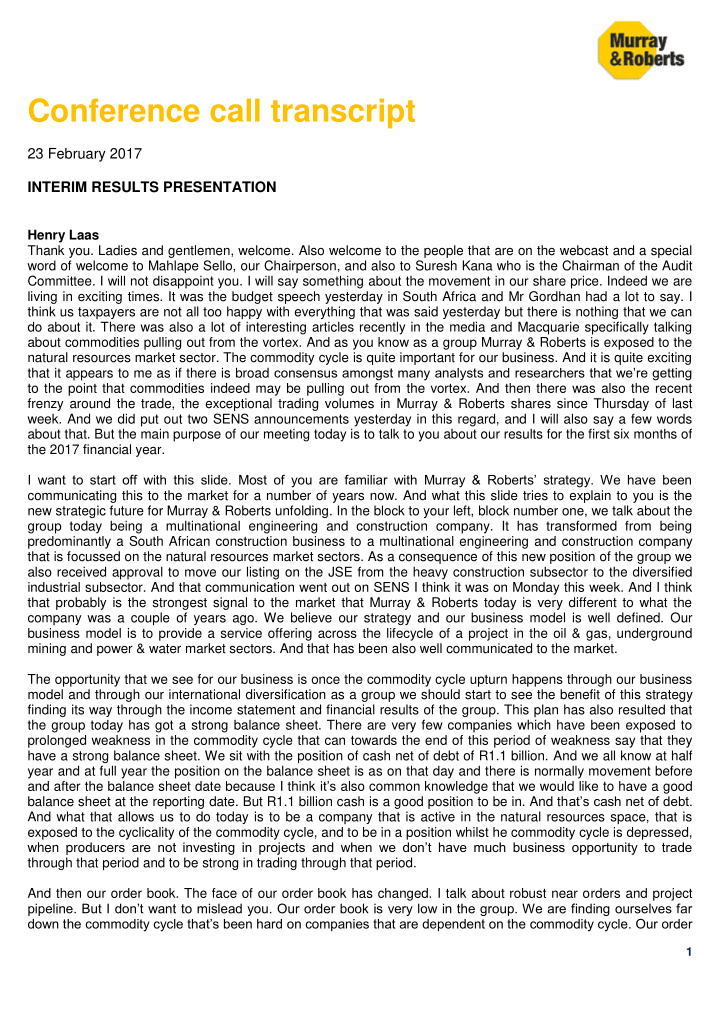



Conference call transcript 23 February 2017 INTERIM RESULTS PRESENTATION Henry Laas Thank you. Ladies and gentlemen, welcome. Also welcome to the people that are on the webcast and a special word of welcome to Mahlape Sello, our Chairperson, and also to Suresh Kana who is the Chairman of the Audit Committee. I will not disappoint you. I will say something about the movement in our share price. Indeed we are living in exciting times. It was the budget speech yesterday in South Africa and Mr Gordhan had a lot to say. I think us taxpayers are not all too happy with everything that was said yesterday but there is nothing that we can do about it. There was also a lot of interesting articles recently in the media and Macquarie specifically talking about commodities pulling out from the vortex. And as you know as a group Murray & Roberts is exposed to the natural resources market sector. The commodity cycle is quite important for our business. And it is quite exciting that it appears to me as if there is broad consensus amongst many analysts and researchers that we’re getting to the point that commodities indeed may be pulling out from the vortex. And then there was also the recent frenzy around the trade, the exceptional trading volumes in Murray & Roberts shares since Thursday of last week. And we did put out two SENS announcements yesterday in this regard, and I will also say a few words about that. But the main purpose of our meeting today is to talk to you about our results for the first six months of the 2017 financial year. I want to start off with this slide. Most of you are familiar with Murray & Roberts’ strategy. We have been communicating this to the market for a number of years now. And what this slide tries to explain to you is the new strategic future for Murray & Roberts unfolding. In the block to your left, block number one, we talk about the group today being a multinational engineering and construction company. It has transformed from being predominantly a South African construction business to a multinational engineering and construction company that is focussed on the natural resources market sectors. As a consequence of this new position of the group we also received approval to move our listing on the JSE from the heavy construction subsector to the diversified industrial subsector. And that communication went out on SENS I think it was on Monday this week. And I think that probably is the strongest signal to the market that Murray & Roberts today is very different to what the company was a couple of years ago. We believe our strategy and our business model is well defined. Our business model is to provide a service offering across the lifecycle of a project in the oil & gas, underground mining and power & water market sectors. And that has been also well communicated to the market. The opportunity that we see for our business is once the commodity cycle upturn happens through our business model and through our international diversification as a group we should start to see the benefit of this strategy finding its way through the income statement and financial results of the group. This plan has also resulted that the group today has got a strong balance sheet. There are very few companies which have been exposed to prolonged weakness in the commodity cycle that can towards the end of this period of weakness say that they have a strong balance sheet. We sit with the position of cash net of debt of R1.1 billion. And we all know at half year and at full year the position on the balance sheet is as on that day and there is normally movement before and after the balance sheet date because I think it’s also common knowledge that we would like to have a good balance sheet at the reporting date. But R1.1 billion cash is a good position to be in. And th at’s cash net of debt. And what that allows us to do today is to be a company that is active in the natural resources space, that is exposed to the cyclicality of the commodity cycle, and to be in a position whilst he commodity cycle is depressed, when pro ducers are not investing in projects and when we don’t have much business opportunity to trade through that period and to be strong in trading through that period. And then our order book. The face of our order book has changed. I talk about robust near orders and project pipeline. But I don’t want to mislead you. Our order book is very low in the group. We are finding ourselves far down the commodity cycle that’s been hard on companies that are dependent on the commodity cycle. Our order 1
Recommend
More recommend